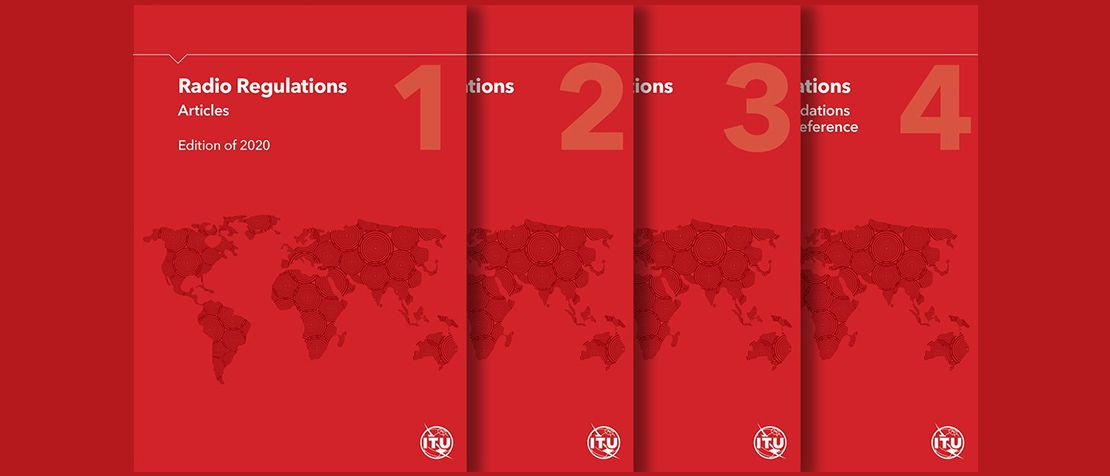
ITU Radio Regulations updated
Today, ITU released an updated version of the world’s only international treaty governing the global use of radio-frequency spectrum and satellite orbits: The Radio Regulations. Entering into force on 1 January 2021, the latest edition of the ITU Radio Regulations are the result of a 4-year process that culminated in four weeks of exhaustive international negotiations held at the World Radiocommunication Conference (WRC-19) last year in Sharm el-Sheikh, Egypt. “The publication of the Radio Regulations is the culmination of the hard work and intense deliberations that took place during WRC-19,” affirmed ITU Secretary-General Houlin Zhao. “Efficient and economical use of the naturally limited radio-frequency spectrum is key to ensuring we bring the benefits of connectivity and digital transformation to people everywhere. The ITU Radio Regulations are a vital vehicle for this endeavour.” Why the Radio Regulations matter The electromagnetic spectrum can be divided into different segments, called ‘frequency bands.’ Radio frequencies can be thought of as natural resources of the global commons, much like land or water. Their finite nature means they must be allocated to different radio services through specific coordination procedures. When it comes to allocating radio frequencies, including sharing, and harmonizing their use for different purposes, the Radio Regulations are the ultimate tool. They ensure the use of the radio-frequency spectrum is rational, equitable, efficient, and economical – all while aiming to prevent harmful interference between different radio services. The ITU Radio Regulations also play an important role in promoting access to affordable broadband for all. “In a rapidly evolving digital wireless world, the Radio Regulations provide an opportunity for all countries to develop innovative ways to promote access to affordable universal next-generation broadband technologies,” highlighted Mario Maniewicz, Director of the ITU Radiocommunication Bureau. Over 40 radiocommunication services covered While radio frequencies are used by many diverse applications, from terrestrial to satellite systems, maritime to aviation, radio and TV broadcasting, space research and more – some frequencies are better suited to a specific type of communication application than others and some applications can only be carried out in specific frequency bands due to their unique propagation characteristics. Moreover, with radio-based technologies advancing at a rapid clip, the world’s airwaves are becoming increasingly crowded. That is where the Radio Regulations come in: over 40 radio communication services are now governed by them. The regulations are designed to both protect existing radio services while enabling the introduction of new and enhanced services. The Radio Regulations have played a part in the actual development of many applications, from short wave and FM radio to digital television broadcasting, Wi-Fi and Bluetooth to satellite positioning (e.g. GPS, Glonass, Galileo or Compass) and satellite television reception. Today, billions of people watch TV through both terrestrial television broadcasting and broadcast satellite services with their associated satellite dishes, in respective frequency bands that have been allocated globally by the ITU Radio Regulations. While they may not be as visible in most of our daily lives, the Radio Regulations also play a key role in enabling satellite imagery and earth resource monitoring, space research, meteorology, maritime and aeronautical transport and safety, as well as civil protection and defence systems. Updating the Radio Regulations: A vital process Making sure the Radio Regulations reflect the changing demand for spectrum use is essential. Their use dates all the way back to 1906, when the first International Radio Telegraph Convention was signed in Berlin, Germany. Since then, the Radio Regulations have evolved over 114 years and 37 subsequent revisions and innovations into the 4-volume treaty of more than 2000 pages. They now cover frequencies ranging from 8.3 kHz to 3000 GHz, with internationally agreed governing principles on which the rights and obligations of ITU’s 193 Member States to use the spectrum and satellite orbit resources are based. “We have published the 2020 ITU Radio Regulations within the agreed timeframe, despite the challenges posed by the global COVID-19 pandemic,” remarked ITU Radiocommunication Bureau Director Mario Maniewicz. “My heartfelt congratulations to all those that have contributed to this great success.”

To download or pre-order the ITU Radio Regulations (2020 edition) in your preferred language, click here.
